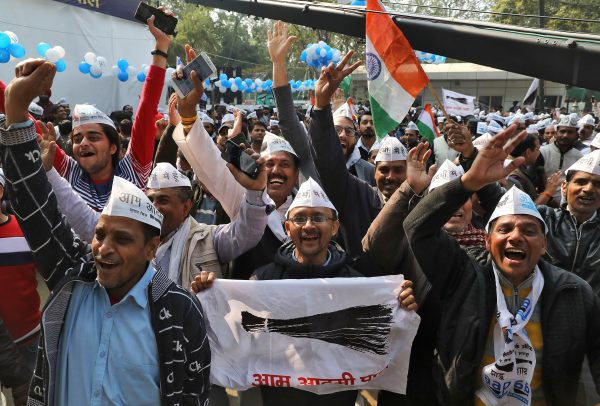Delhi voters considered the record of both power centres as they went to the polls in the February 2020 Delhi Assembly election.
The Aam Aadmi Party (AAP) achieved a spectacular landslide victory for the second time, garnering almost 90 per cent of the total assembly. This represented a robust defeat of its nearest rival the Bhartiya Janata Party (BJP). The third political party, the Indian National Congress (INC) — which has governed Delhi longer than any other party — came in third.
The city witnessed perhaps one of the most vitriolic and polarised BJP campaigns in recent memory. The campaign relied on divisive and incendiary hate speech, with Muslims labelled traitors and terrorists. The AAP’s campaign focused on a ‘politics of development’ and, through realpolitik, avoided the ‘othering’ and ‘us versus them’ narratives laid down by the BJP.
Ideologically, the AAP emerged as a right-of-centre party when it was first established in Delhi in 2012. It has remained so, though it seeks to also establish itself as a welfarist party committed to the problems of the common man and often appeals for political mobilisation in politically neutral terms. In the 2020 election, the AAP successfully portrayed itself as a party free of ideology and deployed characteristic dexterity in skirting some of India’s more burning political issues.
But if the AAP nurtures ambitions to go beyond the regional level and make its presence felt outside Delhi, it will have to engage with issues such as communalism, casteism, regionalism, the Uniform Civil Code, Kashmir and the Citizenship Amendment Act (CAA). The party will have to take positions on these issues while also navigating the underlying nuances of development politics. Political pundits are anxious to see how the AAP plays its cards in the state assembly elections in Bihar later this year, as politics in that state is steeped in issues of caste and communalism.
In Delhi, the AAP’s mantra in the last two elections has been to appeal to middle-class voters and the urban poor, promising them the spill-overs of positive externalities from new public service systems.
The previous AAP government spent a significant portion of its budget on education, health, sewage and water supply. The party promised to provide 24-hour piped water to each household, 24-hour power supply, a continued free 200 units of electricity, mohalla (community) marshals to ensure security for women and traders, 24-hour markets, an amnesty scheme for old VAT cases and legal protection for street vendors. The government brought greater access and equity to primary education and opened up skill development and entrepreneurship universities. The average share of education in Delhi budgets over the last four years has been 24 per cent of the total budget allocation — the highest over any state budget — and the government has made education free up to 12th grade, with increased scholarships to meritorious students.
With considerable effort, the infrastructure of moribund and dilapidated schools was ramped up to improve learning outcomes. The AAP introduced mohalla clinics (neighbourhood hospitals) and brought primary health care — treated as a public service — to the urban poor. The party also made public transport free for women and created subsidies for the poor for electricity.
These actions paid great dividends at election time. The BJP and INC promised in their election manifestos to dole out freebies and subsidies but voters trusted the AAP for its track record. It had a pro-incumbency advantage.
The main takeaway from this election is that the voters of the city rejected communal and divisive politics, appreciated the performance and work ethic of the AAP and threw their support behind a new kind of electoral narrative which could see success beyond Delhi.
Parties that aspire to govern Delhi must grasp its changing cosmopolitanism. The AAP is taking advantage of the arrival of migrants from all across the nation and is ensuring that its policies appeal to this new working class. Now the real question is whether Chief Minister Arvind Kejriwal will be able to use his power responsibly and sustain this performance without becoming either complacent or overambitious.
Tanvir Aeijaz is Associate Professor of Politics and Public Policy at Ramjas College, The University of Delhi.


A well articulated assessment of Delhi elections. The high point of this piece is”The main takeaway from this election is that the voters of the city rejected communal and divisive politics, appreciated the performance and work ethic of the AAP”. Enjoyed reading the article!